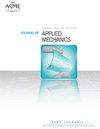具有表面褶皱的可调粘附力学
IF 2.8
4区 工程技术
Q2 MECHANICS
引用次数: 0
摘要
表面褶皱已成为开发具有动态可调附着力的智能粘合剂的一条很有前途的途径,在软机器人和医疗设备等不同领域都有应用。尽管进行了深入的研究并取得了巨大的成就,但由于粗糙的表面拓扑结构和材料内部的预应力,建模和模拟具有表面褶皱的可调粘附仍然具有挑战性。缺乏对机械的理解阻碍了这些智能粘合剂的合理设计。在分子动力学的框架下,我们集成了固体非线性变形的晶格模型和粘附的非局部相互作用势,以探索表面褶皱对粘附行为的作用。我们通过将新胡克双层中的褶皱与基准结果进行比较来验证所提出的模型,并重现圆柱形粘附的分析解。然后,我们系统地研究了具有不同压缩应变和粘附能的褶皱表面的拉脱力。我们的结果揭示了粘附诱导的接触与皱纹引起的粗糙度之间的竞争效应,从而增强或削弱了粘附性。这种理解为剪裁材料和几何形状以及为不同应用加载褶皱表面提供了指导。本文章由计算机程序翻译,如有差异,请以英文原文为准。
Mechanics of tunable adhesion with surface wrinkles
Surface wrinkles have emerged as a promising avenue for the development of smart adhesives with dynamically tunable adhesion, finding applications in diverse fields, such as soft robots and medical devices. Despite intensive studies and great achievements, it is still challenging to model and simulate the tunable adhesion with surface wrinkles due to roughened surface topologies and pre-stress inside the materials. The lack of a mechanistic understanding hinders the rational design of these smart adhesives. Here we integrate a lattice model for nonlinear deformations of solids and nonlocal interaction potentials for adhesion in the framework of molecular dynamics to explore the roles of surface wrinkles on the adhesion behaviors. We validate the proposed model by comparing wrinkles in a neo-Hookean bilayer with benchmarked results and reproducing the analytical solution for cylindrical adhesion. We then systematically study the pull-off force of the wrinkled surface with varied compressive strains and adhesion energies. Our results reveal the competing effect between the adhesion induced contact and the roughness due to wrinkles on enhancing or weakening the adhesion. Such understanding provides guidance for tailoring material and geometry as well as loading of the wrinkled surfaces for different applications.
求助全文
通过发布文献求助,成功后即可免费获取论文全文。
去求助
来源期刊
CiteScore
4.80
自引率
3.80%
发文量
95
审稿时长
5.8 months
期刊介绍:
All areas of theoretical and applied mechanics including, but not limited to: Aerodynamics; Aeroelasticity; Biomechanics; Boundary layers; Composite materials; Computational mechanics; Constitutive modeling of materials; Dynamics; Elasticity; Experimental mechanics; Flow and fracture; Heat transport in fluid flows; Hydraulics; Impact; Internal flow; Mechanical properties of materials; Mechanics of shocks; Micromechanics; Nanomechanics; Plasticity; Stress analysis; Structures; Thermodynamics of materials and in flowing fluids; Thermo-mechanics; Turbulence; Vibration; Wave propagation

 求助内容:
求助内容: 应助结果提醒方式:
应助结果提醒方式:


